Now that you have your vision you need to be able to sell it to the world. Perhaps your vision is to transform every family's home into a smart home that protects their loved ones providing peace of mind.
Parents won't need to effortlessly monitor and protect what matters most - their children and home. Kids will be able to explore and engage in their surroundings in safe, enriching ways. Homes will be made smarter, safer and more efficient without complexity or compromise. You see a future where your system secures people's most valuable asset, becomes their trusted partner, and lets them focus on moments that matter.
While this vision is inspiring it isn't enough. You will need to understand how you will achieve it. A strategic framework articulates the underlying logic and reasoning behind your vision.
A strategic framework lays the groundwork of how you expect to achieve your vision.
For example, Apple's strategic framework for its products revolves around delivering the best user experience through tightly integrated hardware, software, and services. On the hardware front, Apple focuses relentlessly on design, miniaturization, and maximizing performance. Its in-house chip design pushes the envelope on processing power and energy efficiency. Apple pairs this hardware prowess with its proprietary iOS and macOS to enable fluid, intuitive software experiences. The App Store provides easy access to third-party apps that complement the ecosystem.
Finally, Apple offers services like iCloud, Apple Music, and Apple Pay that integrate with devices and lock users into its closed universe. This end-to-end control over the user journey - from silicon to software to services - is the bedrock of Apple's strategy to provide unmatched usability, consistency, and stickiness.
The ultimate goal is to delight users and keep them loyal to Apple products by making everything effortlessly work together through a magical confluence of industrial design and engineering.
Foresight
Learn the market and industry to uncover opportunities and obstacles
When creating your strategy you need to figure out how your company will keep score and stay ahead. In order to make sure this happens you will need a solid business model, a great brand, and exceptional competitive positioning.
💁♀️ Tip: Make sure your brand has purpose, stands out from it's competitors, and can guide your entire business model.
As you develop your product strategy you should keep in mind the following:
Business:
- What is the company's mission, vision, and strategy?
- Top Priorities?
- Competitive Advantage?
- Create or Dive into the SWOT Analysis (Strengths, Weaknesses, Opportunities, or Threats)
- Company Business Model?
- Company Objectives?
- Company Goals and KPI's?
- What are the other teams and their goals? Is their synergy?
- How will you and your team align with all of this?
Market & Industry
- Who are your target personas? What do they need? What do they want? How are they choosing products?
- Who are your competitors? How are they differentiating themselves? What do they do well? What are the similiarties and what are the differences?
- What is your hook that differentiates you from your competition?
- How is your product currently viewed in the market?
- What are the current trends that can affect your business?
- Where/What are the opportunities and obstacles?
Cleary identify your target customer and their pain points
Clearly identifying your target customers and their pain points is crucial for company success. Even small misconceptions about the target audience can cause big problems later. Rather than making assumptions, validate who your customers are and what they need through research - behavioral studies, attitudinal surveys, etc.
Taking the time upfront to deeply understand your customers via data insights is far better than risking moving forward with an inaccurate view of the target market. Assumptions and guesses about the audience open the door for failure. Do the research, get crystal clear on the target persona and their motivations, and let customer truth guide strategy.
Companies often understand the features their products offer, but lack insight into the deeper underlying problems those features solve for customers. It's crucial to uncover the true motivations driving customer behavior - not just which features are used, but 'why' they matter and 'what' needs they fulfill. Without connecting to the deeper 'why' behind consumer choices, companies miss opportunities to improve the customer experience and provide greater value.
Also, when evaluating customer pain points, ensure your metrics provide real insight rather than vanity metrics that sound good but lack meaning. For example, a goal to increase product usage should track actual user engagement, not just downloads. 10,000 downloads in a month sounds impressive but reveals nothing about whether those users actively used the product. Choose metrics that connect to true customer problems and desired outcomes.
The following are some questions you should ask yourself when identifying or diving into your current target personas:
- Types of Users: Will you start with power users or basic users?
- Competitive Landscape: Which competitors can you win customers from?
- Growth Strategy: Will you upsell existing customers or gain new ones?
- Achieving 10X: Does your solution feel 10X better for your target customers?
- Demographics - age, gender, location, income, etc.
- Values and interests - what motivates them?
- Behaviors - where/when do they shop? how do they use your product?
- Pain points- what frustrations and problems need solving?
- Objections - what prevents them from purchasing?
- Influencers - who sways their decisions?
- Brand perceptions - how do they view your brand?
- Goals and aspirations - how does your product help them achieve goals?
- Unique attributes - what makes this persona distinct?
💁♀️ Tip: When going after a target market you should capture a large part of a small market. You will need high penetration for some specific market.
To clearly identify target customers and their pain points, collaborate across departments. Connect with sales, marketing, customer success, engineering, user research, operations, and other teams interacting with customers. Cross-functional insight narrows the focus on who your real target customers are and what they need. Different teams have unique perspectives that complete the picture. Leverage expertise across the organization to hone in on precise customer profiles and opportunities.
Growing Pains
Address common questions in your strategic framework
A strategic framework aims to create alignment around a vision by proactively addressing questions that you are likely to be challenged with. It provides guidance and boundaries to keep teams on track toward the vision.
An effective strategic framework will anticipate areas of misalignment and outline clear logic to steer decisions and initiatives.
With a sound framework in place, teams have a shared roadmap and context for decision-making that keeps focus on the organization's north star.
Here are items to think about when creating your strategic framework...
- What questions are most commonly brought up by various teams. For example, does sales ask about expanding the features of the product? Include this section in the framework.
- Is there an ongoing debate over prioritization?
- What were the other directions that could've been taken? Provide context and explain why you chose the one you did.
- What solutions are your teams considering? The strategy should provide a framework that steers people towards the best ones.
💁♀️ Tip: Once you have narrowed down the answers to the above questions you will need to gradually simplify and clarify your strategy. The goal is to make it simple and not complicated. Always ask why and then group things together that share a common 'why.'
Think BIGGER Picture
You will need to align your strategy with the bigger picture. Strategies will be different across the company depending on the work that is being done, but in the end they all need to align into the larger product strategy that fits into the company strategy.
Ensure your team's product strategy aligns with the company's overall strategic direction. If the company strategy is to remain domestic, then it would be counterproductive for your team to pursue an international expansion product strategy. Your strategies should complement, not contradict, the strategies at the broader company level.
Additionally, review strategies from other teams across the company. While these are often stored centrally, you may need to connect with colleagues to obtain them. Don't be concerned if you find missing vision statements, frameworks, or roadmaps. Instead, view this as a collaborative opportunity to help teams develop aligned strategies that ladder up to the company strategy.
🚨 Important Note: Don't assume others will see how your strategy fits the big picture. Explain the connections clearly. Show step-by-step how your strategy helps reach higher company goals. If the company wants revenue growth and you focus on user growth, connect the dots between more users and more revenue. Spell out exactly how your goals ladder up to what matters company-wide. Make the path obvious - don't leave it to guesswork.
Concepts and Frameworks
Customer Purchase Decision-Making Process
There are common frameworks that model the customer decision-making process, like AIDA and REAN. These frameworks help identify target markets and focus attention by mapping the journey to purchase. For example, AIDA outlines the stages of Attention, Interest, Desire, and Action that lead to a buyer's decision. REAN describes Reach, Engagement, Activation and Nurture.
Using established decision-making frameworks provides structure for analyzing your market and a guiding strategy to steer customers through each step toward conversion and loyalty. They enable more nuanced targeting and messaging tailored to where each customer is within the progression.
AIDA Framework
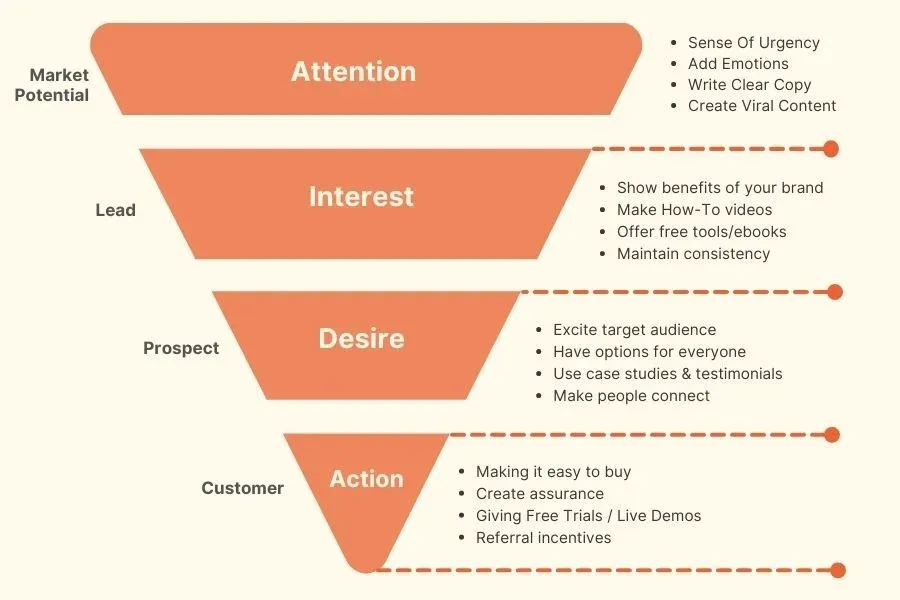
Coca-Cola leveraged the AIDA framework when marketing the launch of Coke Zero. The strategy guided messaging and initiatives for each phase, including:
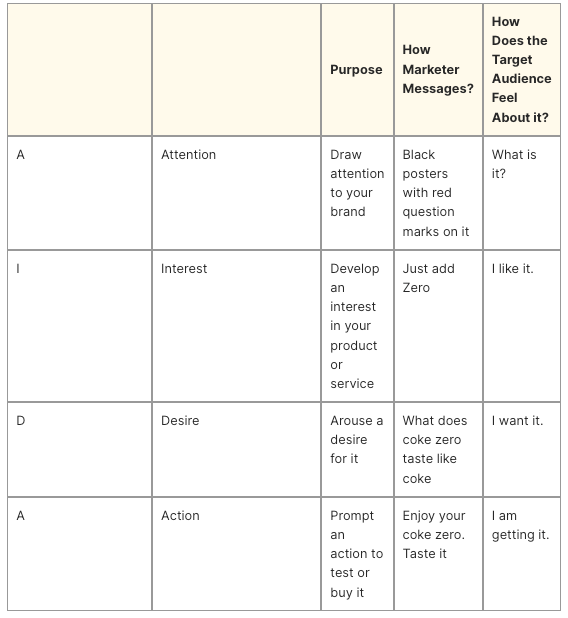
AIDA Model for Coke Zero defined:
Attention - Eye-catching ads with energetic men singing about Coke Zero generated buzz and awareness.
Interest - Sampling campaigns and personality-driven ads piqued curiosity in the new offering.
Desire - Associating Coke Zero with fun times and youthful energy positioned it as an aspirational lifestyle drink.
Action - Coupons, in-store displays and advertising drove trial purchases and conversion to sales.
By mapping campaign elements to the AIDA model, Coca-Cola ensured messaging matched customers' mindset as they moved from unawareness to purchase. The framework provided structure for tailored content and nudging consumers through each sequential stage.
Let's break it down by each process:
Attention (Awareness): how do you plan on getting the customers attention? Will you run a social media campaign? Social media buzz, influencer promotions and targeted ads? Give away free samples? Contests?
Interest: Once, you have the customers attention, you will need to get them interested in your product. What are the advantages or benefits of your product?
Desire: You need to convince them to buy your product. They have to WANT it!
Action: The desire will need to be strong enough to finally take action to purchase the product.
REAN
While AIDA provides a solid framework for attracting and converting new customers, REAN takes a longer-term view needed for customer retention. The REAN model outlines the stages of Reach, Engagement, Activation and Nurturing on the path to loyal customer relationships. Once customers are acquired through AIDA, REAN focuses on continually reaching them with relevant messaging while deepening engagement through positive brand interactions.
REAN Framework
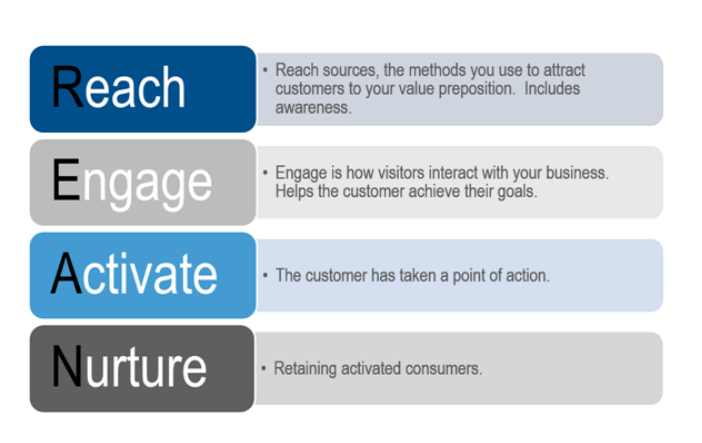
The REAN model outlines four stages:
Reach - Build awareness so the customer knows about your product.
Engage - Capture interest so the customer actively considers your product.
Activate - Prompt action so the customer makes a purchase.
Nurture - Provide ongoing care so the customer feels valued after purchasing.
REAN provides a strategic framework for moving customers through each phase, from initial awareness to loyal brand advocate. Reach generates recognition. Engage spurs consideration. Activate converts interest into sales. Nurture retains customers by meeting their needs post-purchase.
Marketing Mix-The 4 P's
The 4 P's of marketing refer to the traditional framework used to develop strategies for influencing consumers. The 4 P's stand for Product, Price, Promotion and Place.
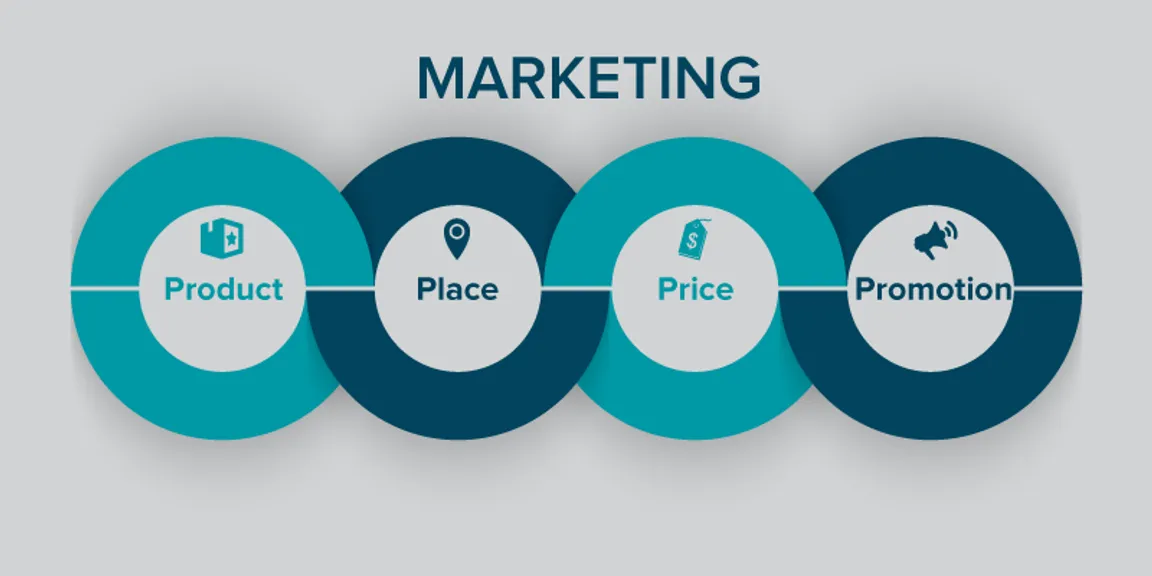
Product: The actual good or service being offered to meet customer wants and needs.
Price: The cost of the product which impacts affordability and target customer segments.
Promotion: Includes advertising, public relations, sales, and word-of-mouth used to inform customers.
Place: The distribution channels and physical or digital product accessibility for customers.
Product represents the combination of goods and services an organization offers to target markets. Price indicates the positioning based on value perceptions and competitive pricing tactics. Promotion encompasses the advertising, PR, sales and other techniques used to communicate with consumers. Finally, Place refers to routes to market and distribution channels for delivering products and services to customers.
Considering these four dimensions provides a rounded perspective on how to effectively attract, convert and retain consumers. The 4 P's model delivers a mix of tactical levers spanning brand messaging, pricing optimization, distribution footprints and product feature sets. Mastering the interplay between these factors is key to addressing consumer needs and constructing an impactful marketing strategy.
SWOT Analysis
While the marketing mix (4Ps) provides a solid tactical plan for influencing customers, a SWOT analysis assesses the broader internal and external factors that can impact marketing success. Conducting a SWOT highlights the favorable and unfavorable elements that shape the landscape in which marketing campaigns operate. The strengths and weaknesses look inward at the organization's internal capabilities, resources, processes, and culture. Opportunities and threats look outward at the market landscape, competition, industry trends, and macro forces. Together, they provide a holistic 360-degree view of the strategic context.
A SWOT analysis is a framework for evaluating a company's Strengths, Weaknesses, Opportunities, and Threats. It builds on the marketing mix by adding internal and external dimensions.
The SWOT gives insight into potential blind spots, competitive advantages, and external shifts to capitalize on or mitigate. With this perspective, the marketing mix can be refined to leverage opportunities or address challenges revealed by the SWOT assessment. The combination of marketing mix tactics and SWOT analysis provides strategy from both executional and environmental standpoints.
The following matrix represents the SWOT Structure:
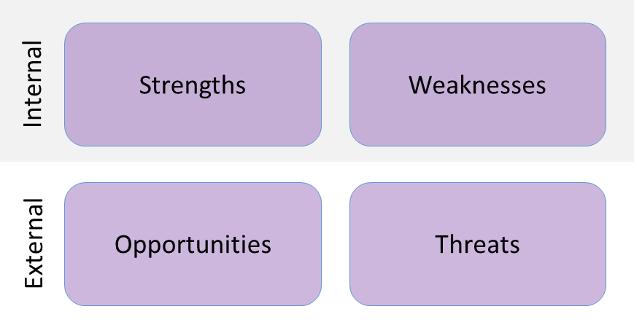
The SWOT framework helps to decide whether to pursue an opportunity and what strategies would work best to further that pursuit.
The Five C's
While a SWOT analysis assesses internal and external dynamics, the Five C’s of situational analysis take a deeper dive into the external environment. Specifically, the Five C’s framework analyzes the Company itself, Competitive environment, Customers, Collaborators (partners), and Climate (external forces.) This approach builds on the outward-looking “OT” of a SWOT to comprehensively scan the key components of a company’s ecosystem.
Assessing competitors helps benchmark strengths/weaknesses and uncover strategic openings. Examining collaborators highlights partnership opportunities. Understanding customers, their needs and the market clarifies growth potential. Finally, analyzing macro forces reveals obstacles or tailwinds that will impact operations.
The 5 C's analysis provides a 360 view of the most critical elements in a company's external operating environment to guide data-driven strategy.
The Five C’s framework provides structured analysis of the most critical external elements, allowing companies to make informed strategic decisions aligned with marketplace realities. It expands on a SWOT analysis with a more focused external assessment. Conducting a 5 C's analysis helps guide strategic decisions such as whether to launch a product and what strategic approach to take.
Final Words
The best product doesn't always win just like the best team doesn't always win. You need more than a great product. You also have to think about the market, pricing, competition, your company's goals, and other business factors. Don't just try to make the perfect product. Prioritize trade-offs between what customers want and business needs. Focus on making a product that's "good enough" to balance customer and company priorities. This thoughtful strategy is key to winning in the real world, not just on paper.
Teams feel greater purpose when they can grasp how their work impacts company goals. A strategic framework outlines these connections explicitly. This motivates and energizes people to do their best work. When the path from daily tasks to overarching mission is unclear, engagement suffers. But when teams see their contribution to the big picture, passion is ignited.
Beyond just stating company objectives, strategic frameworks explain how each team's efforts map to priorities. This sense of meaning and alignment unlocks productivity. Success requires more than just skilled people. It demands people who feel their work matters. Strategic frameworks create this emotional commitment by illustrating the impact of each person’s work.
Next Steps
- SWOT Analysis: What is it and How do I use it?
- AIDA Model in Marketing: How to Increase Conversions at Each Stage using Rewards
- The 5 C's of marketing